重庆医科大学:《病理学》课程作业习题(英文,无答案)
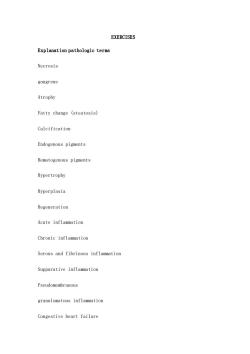
EXERCISES Explanation pathologic terms Necrosis gangrene Atrophy Fatty change (steatosis) Calcification Endogenous pigments Hematogenous pigments Hypertrophy Hyperplasia Regeneration Acute inflammation Chronic inflammation Serous and fibrinous inflammation Suppurative inflammation Pseudomembranous granulomatous inflammation Congestive heart failure
EXERCISES Explanation pathologic terms Necrosis gangrene Atrophy Fatty change (steatosis) Calcification Endogenous pigments Hematogenous pigments Hypertrophy Hyperplasia Regeneration Acute inflammation Chronic inflammation Serous and fibrinous inflammation Suppurative inflammation Pseudomembranous granulomatous inflammation Congestive heart failure
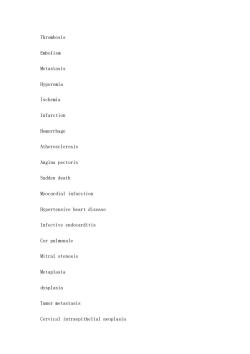
Thrombosis Embolism Metastasis Hyperemia Ischemia Infarction Hemorrhage Atherosclerosis Angina pectoris Sudden death Myocardial infarction Hypertensive heart disease Infective endocarditis Cor pulmonale Mitral stenosis Metaplasia dysplasia Tumor metastasis Cervical intraepithelial neoplasia
Thrombosis Embolism Metastasis Hyperemia Ischemia Infarction Hemorrhage Atherosclerosis Angina pectoris Sudden death Myocardial infarction Hypertensive heart disease Infective endocarditis Cor pulmonale Mitral stenosis Metaplasia dysplasia Tumor metastasis Cervical intraepithelial neoplasia
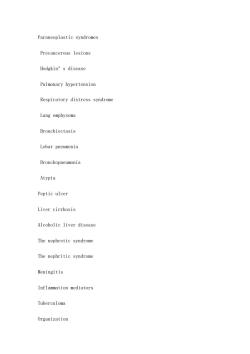
Paraneoplastic syndromes Precancerous lesions Hodgkin°s disease Pulmonary hypertension Respiratory distress syndrome Lung emphysema Bronchiectasis Lobar pneumonia Bronchopneumonia Atypia Peptic ulcer Liver cirrhosis Alcoholic liver disease The nephrotic syndrome The nephritic syndrome Meningitis Inflammation mediators Tuberculoma Organization
Paraneoplastic syndromes Precancerous lesions Hodgkin°s disease Pulmonary hypertension Respiratory distress syndrome Lung emphysema Bronchiectasis Lobar pneumonia Bronchopneumonia Atypia Peptic ulcer Liver cirrhosis Alcoholic liver disease The nephrotic syndrome The nephritic syndrome Meningitis Inflammation mediators Tuberculoma Organization
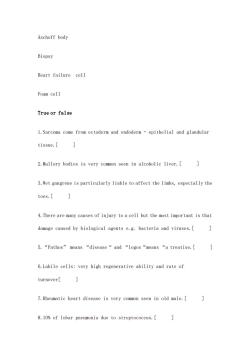
Aschoff body Biopsy Heart failure cell Foam cell True or false 1.Sarcoma come from ectoderm and endoderm-epithelial and glandular tissue.[ 2.Mallory bodies is very common seen in alcoholic liver. 3.Wet gangrene is particularly liable to affect the limbs,especially the toes.[ 4.There are many causes of injury to a cell but the most important is that damage caused by biological agents e.g.bacteria and viruses. 5.“Pathos”means“disease“and“logos“means“a treatise.[] 6.Labile cells:very high regenerative ability and rate of turnover[ 7.Rheumatic heart disease is very common seen in old male. 8.10%of lobar pneumonia due to streptococcus.[
Aschoff body Biopsy Heart failure cell Foam cell True or false 1.Sarcoma come from ectoderm and endoderm - epithelial and glandular tissue.[ ] 2.Mallory bodies is very common seen in alcoholic liver.[ ] 3.Wet gangrene is particularly liable to affect the limbs, especially the toes.[ ] 4.There are many causes of injury to a cell but the most important is that damage caused by biological agents e.g. bacteria and viruses.[ ] 5.“Pathos” means “disease“ and “logos“means “a treatise.[ ] 6.Labile cells: very high regenerative ability and rate of turnover[ ] 7.Rheumatic heart disease is very common seen in old male.[ ] 8.10% of lobar pneumonia due to streptococcus.[ ]
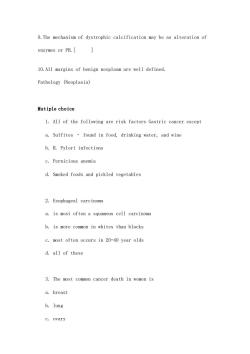
9.The mechanism of dystrophic calcification may be as alteration of enzymes or PH. ] 10.All margins of benign neoplasm are well defined. Pathology (Neoplasia) Mutiple choice 1.All of the following are risk factors Gastric cancer except a.Sulfites found in food,drinking water,and wine b.H.Pylori infections c.Pernicious anemia d.Smoked foods and pickled vegetables 2.Esophageal carcinoma a.is most often a squamous cell carcinoma b.is more common in whites than blacks c.most often occurs in 20-40 year olds d.all of these 3.The most common cancer death in women is a.breast b.lung c.ovary
9.The mechanism of dystrophic calcification may be as alteration of enzymes or PH.[ ] 10.All margins of benign neoplasm are well defined. Pathology (Neoplasia) Mutiple choice 1. All of the following are risk factors Gastric cancer except a. Sulfites – found in food, drinking water, and wine b. H. Pylori infections c. Pernicious anemia d. Smoked foods and pickled vegetables 2. Esophageal carcinoma a. is most often a squamous cell carcinoma b. is more common in whites than blacks c. most often occurs in 20-40 year olds d. all of these 3. The most common cancer death in women is a. breast b. lung c. ovary
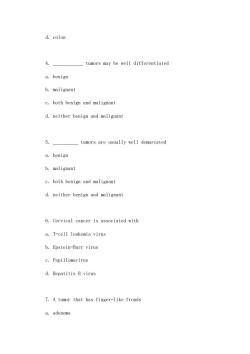
d.colon 4. tumors may be well differentiated a.benign b.malignant c.both benign and malignant d.neither benign and malignant 5. tumors are usually well demarcated a.benign b.malignant c.both benign and malignant d.neither benign and malignant 6.Cervical cancer is associated with a.T-cell leukemia virus b.Epstein-Barr virus c.Papillomavirus d.Hepatitis B virus 7.A tumor that has finger-like fronds a.adenoma
d. colon 4. _ tumors may be well differentiated a. benign b. malignant c. both benign and malignant d. neither benign and malignant 5. _ tumors are usually well demarcated a. benign b. malignant c. both benign and malignant d. neither benign and malignant 6. Cervical cancer is associated with a. T-cell leukemia virus b. Epstein-Barr virus c. Papillomavirus d. Hepatitis B virus 7. A tumor that has finger-like fronds a. adenoma
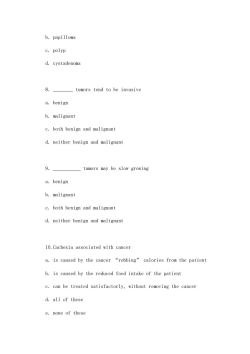
b.papilloma c.polyp d.cystadenoma 8. tumors tend to be invasive a.benign b.malignant c.both benign and malignant d.neither benign and malignant 9. tumors may be slow growing a.benign b.malignant c.both benign and malignant d.neither benign and malignant 10.Cachexia associated with cancer a.is caused by the cancer "robbing"calories from the patient b.is caused by the reduced food intake of the patient c.can be treated satisfactorly,without removing the cancer d.all of these e.none of these
b. papilloma c. polyp d. cystadenoma 8. _ tumors tend to be invasive a. benign b. malignant c. both benign and malignant d. neither benign and malignant 9. _ tumors may be slow growing a. benign b. malignant c. both benign and malignant d. neither benign and malignant 10.Cachexia associated with cancer a. is caused by the cancer “robbing” calories from the patient b. is caused by the reduced food intake of the patient c. can be treated satisfactorly, without removing the cancer d. all of these e. none of these

11.Cushing's syndrome,as a paraneoplastic syndrome,is associated with a.histamine b.erythropoietin c.ACTH d.Parathyroid hormone 12.Burkitts lymphoma is associated with a.T-cell leukemia virus b.Epstein-Barr virus c.Papilloma virus d.Hepatitis B virus 13.In general the lung cancer with the best prognosis is a.small cell cancer b.non-small cell cancer c.mixed cell cancer d.bronchial carcinoid 14. tumors may be clinically significant a.benign b.malignant
11.Cushing’s syndrome, as a paraneoplastic syndrome, is associated with a. histamine b. erythropoietin c. ACTH d. Parathyroid hormone 12.Burkitts lymphoma is associated with a. T-cell leukemia virus b. Epstein-Barr virus c. Papilloma virus d. Hepatitis B virus 13.In general the lung cancer with the best prognosis is a. small cell cancer b. non-small cell cancer c. mixed cell cancer d. bronchial carcinoid 14._ tumors may be clinically significant a. benign b. malignant
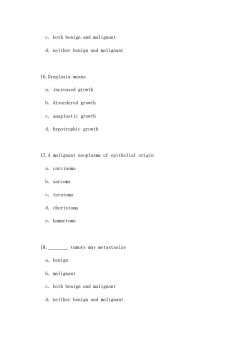
c.both benign and malignant d.neither benign and malignant 16.Dysplasia means a.increased growth b.disordered growth c.anaplastic growth d.hypotrophic growth 17.A malignant neoplasma of epithelial origin a.carcinoma b.sarcoma c.teratoma d.choristoma e.hamartoma 18.tumors may metastasize a.benign b.malignant c.both benign and malignant d.neither benign and malignant
c. both benign and malignant d. neither benign and malignant 16.Dysplasia means a. increased growth b. disordered growth c. anaplastic growth d. hypotrophic growth 17.A malignant neoplasma of epithelial origin a. carcinoma b. sarcoma c. teratoma d. choristoma e. hamartoma 18._ tumors may metastasize a. benign b. malignant c. both benign and malignant d. neither benign and malignant
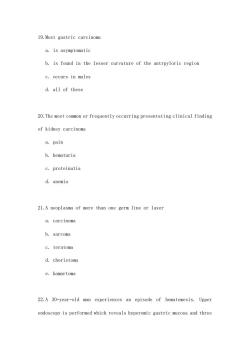
19.Most gastric carcinoma a.is asymptomatic b.is found in the lesser curvature of the antrpyloric region c.occurs in males d.all of these 20.The most common or frequently occurring presentating clinical finding of kidney carcinoma a.pain b.hematuria c.proteinutia d.anemia 21.A neoplasma of more than one germ line or layer a.carcinoma b.sarcoma c.teratoma d.choristoma e.hamartoma 22.A 30-yearold man experiences an episode of hematemesis.Upper endoscopy is performed which reveals hyperemic gastric mucosa and three
19.Most gastric carcinoma a. is asymptomatic b. is found in the lesser curvature of the antrpyloric region c. occurs in males d. all of these 20.The most common or frequently occurring presentating clinical finding of kidney carcinoma a. pain b. hematuria c. proteinutia d. anemia 21.A neoplasma of more than one germ line or layer a. carcinoma b. sarcoma c. teratoma d. choristoma e. hamartoma 22.A 30-year-old man experiences an episode of hematemesis. Upper endoscopy is performed which reveals hyperemic gastric mucosa and three
按次数下载不扣除下载券;
注册用户24小时内重复下载只扣除一次;
顺序:VIP每日次数-->可用次数-->下载券;
- 重庆医科大学:《病理学》课程教学实习指导(英文).doc
- 重庆医科大学:《病理学》课程课程教学大纲 A Teaching Outline for Pathology Course.doc
- 重庆医科大学:《病理学》课程理论教学大纲(供七年制和五年制使用).doc
- 重庆医科大学:《病理学》课程教学资源(PPT课件)传染病与寄生虫病(infectious desease and parasitosis).ppt
- 重庆医科大学:《病理学》课程教学资源(PPT课件)神经系统疾病(Diseases of the CNS).ppt
- 重庆医科大学:《病理学》课程教学资源(PPT课件)内分泌系统疾病.ppt
- 重庆医科大学:《病理学》课程教学资源(PPT课件)女性生殖系统疾病(disease of female reproductive system and breast).ppt
- 重庆医科大学:《病理学》课程教学资源(PPT课件)泌尿系统疾病 Diseases of urinary system.ppt
- 重庆医科大学:《病理学》课程教学资源(PPT课件)消化系统疾病 Digestive system disease.ppt
- 重庆医科大学:《病理学》课程教学资源(PPT课件)呼吸系统疾病.ppt
- 重庆医科大学:《病理学》课程教学资源(PPT课件)心血管疾病 Diseases of Cardiovascular system.ppt
- 重庆医科大学:《病理学》课程教学资源(PPT课件)肿瘤(tumor, neoplasm).ppt
- 重庆医科大学:《病理学》课程教学资源(PPT课件)炎症 inflammation.ppt
- 重庆医科大学:《病理学》课程教学资源(PPT课件)局部血液循环障碍.ppt
- 重庆医科大学:《病理学》课程教学资源(PPT课件)绪论、细胞和组织的适应与损伤、损伤的修复.ppt
- 《病理学》课程作业习题(含参考答案).pdf
- 《病理学》课程实习指导 Guidance of Pathology.pdf
- 《病理学》课程教学大纲(五年制临床、儿科、麻醉、基础、预防、口腔医学专业使用;七年制临床、儿科、检验、物理专业使用).docx
- 《遗传与优生学》课程教学资源(课件讲稿)第8章 遗传咨询(genetic counseling).pdf
- 《遗传与优生学》课程教学资源(课件讲稿)第7章 肿瘤遗传学.pdf
- 重庆医科大学:《病理学》课程英文试卷(试题).doc
- 重庆医科大学:《病理学》课程英文试卷(答案).doc
- 重庆医科大学:《病理学》课程教学资源(授课教案)infectious disease.doc
- 重庆医科大学:《病理学》课程教学资源(授课教案)the Diseases of female genital system.doc
- 重庆医科大学:《病理学》课程教学资源(授课教案)disease of nevous system_1.doc
- 重庆医科大学:《病理学》课程教学资源(授课教案)disease of nevous system_2.doc
- 重庆医科大学:《病理学》课程教学资源(授课教案)diseases of cardiovascular system.doc
- 重庆医科大学:《病理学》课程教学资源(授课教案)diseases of respiratory system.doc
- 重庆医科大学:《病理学》课程教学资源(授课教案)disease of alimentary system.doc
- 重庆医科大学:《病理学》课程教学资源(授课教案)disease of urinary system.doc
- 重庆医科大学:《病理学》课程教学资源(授课教案)cell adaptation and injury, repair.doc
- 重庆医科大学:《病理学》课程教学资源(授课教案)tumor.doc
- 重庆医科大学:《病理学》课程教学资源(授课教案)Introduction and hemodynamic rearangment.doc
- 重庆医科大学:《病理学》课程教学资源(授课教案)inflammation.doc
- 重庆医科大学:《病理学》课程教学资源(授课教案)内分泌系统疾病.doc
- 重庆医科大学:《病理学》课程教学资源(授课教案)传染和寄生虫病.doc
- 重庆医科大学:《病理学》课程教学资源(授课教案)女性生殖系统疾病.doc
- 重庆医科大学:《病理学》课程教学资源(授课教案)神经系统疾病.doc
- 重庆医科大学:《病理学》课程教学资源(授课教案)心血管系统疾病.doc
- 重庆医科大学:《病理学》课程教学资源(授课教案)呼吸系统疾病.doc
